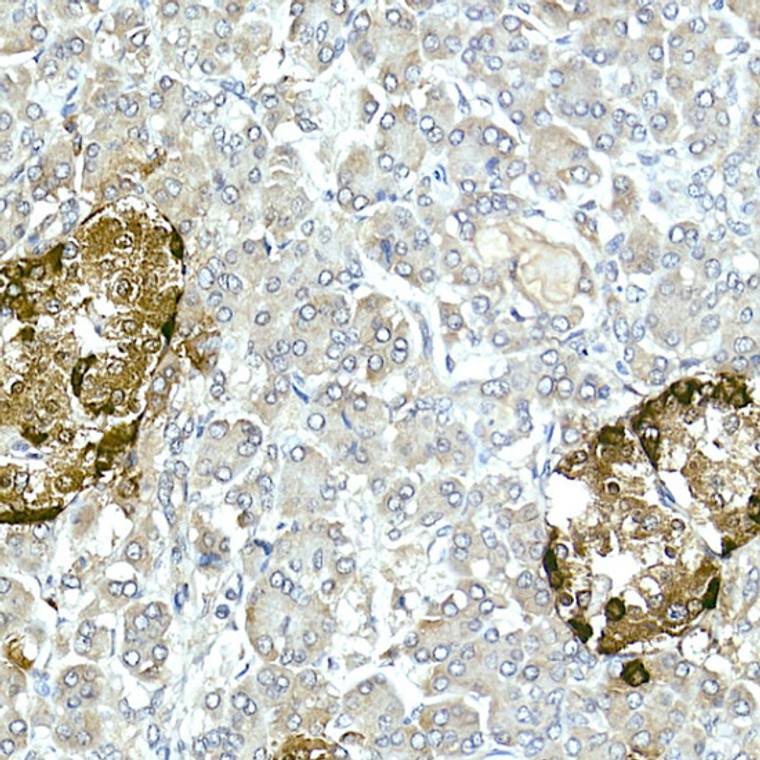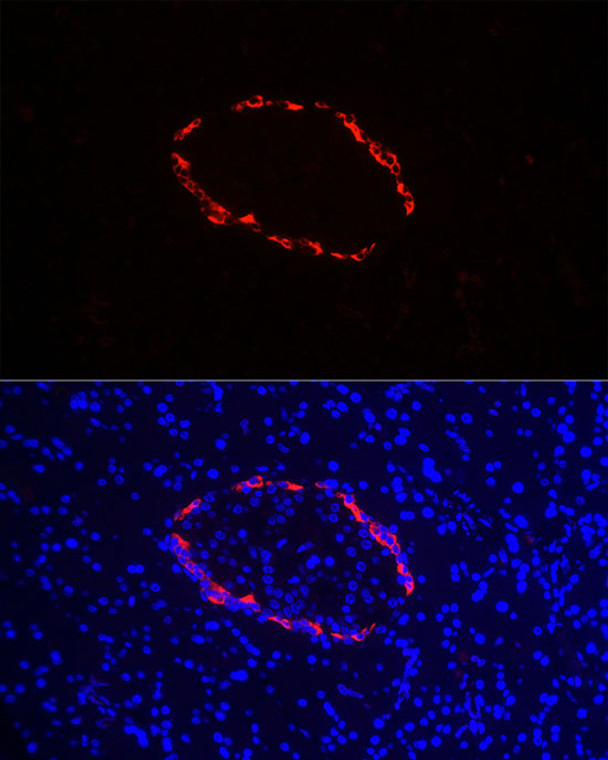| Host: |
Rabbit |
| Applications: |
WB/IHC/IF |
| Reactivity: |
Human/Mouse/Rat |
| Note: |
STRICTLY FOR FURTHER SCIENTIFIC RESEARCH USE ONLY (RUO). MUST NOT TO BE USED IN DIAGNOSTIC OR THERAPEUTIC APPLICATIONS. |
| Short Description: |
Rabbit polyclonal antibody anti-GCG (21-180) is suitable for use in Western Blot, Immunohistochemistry and Immunofluorescence research applications. |
| Clonality: |
Polyclonal |
| Conjugation: |
Unconjugated |
| Isotype: |
IgG |
| Formulation: |
PBS with 0.05% Proclin300, 50% Glycerol, pH7.3. |
| Purification: |
Affinity purification |
| Dilution Range: |
WB 1:500-1:2000IHC-P 1:50-1:200IF/ICC 1:50-1:200 |
| Storage Instruction: |
Store at-20°C for up to 1 year from the date of receipt, and avoid repeat freeze-thaw cycles. |
| Gene Symbol: |
GCG |
| Gene ID: |
2641 |
| Uniprot ID: |
GLUC_HUMAN |
| Immunogen Region: |
21-180 |
| Immunogen: |
Recombinant fusion protein containing a sequence corresponding to amino acids 21-180 of human Pro-glucagon (NP_002045.1). |
| Immunogen Sequence: |
RSLQDTEEKSRSFSASQADP LSDPDQMNEDKRHSQGTFTS DYSKYLDSRRAQDFVQWLMN TKRNRNNIA |
| Tissue Specificity | Glucagon: Secreted in the A cells of the islets of Langerhans. Glucagon-like peptide 1: Secreted in the A cells of the islets of Langerhans. Secreted from enteroendocrine L cells throughout the gastrointestinal tract. Also secreted in selected neurons in the brain. Glucagon-like peptide 2: Secreted from enteroendocrine cells throughout the gastrointestinal tract. Also secreted in selected neurons in the brain. Glicentin: Secreted from enteroendocrine cells throughout the gastrointestinal tract. Oxyntomodulin: Secreted from enteroendocrine cells throughout the gastrointestinal tract. |
| Post Translational Modifications | Proglucagon is post-translationally processed in a tissue-specific manner in pancreatic A cells and intestinal L cells. In pancreatic A cells, the major bioactive hormone is glucagon cleaved by PCSK2/PC2. In the intestinal L cells PCSK1/PC1 liberates GLP-1, GLP-2, glicentin and oxyntomodulin. GLP-1 is further N-terminally truncated by post-translational processing in the intestinal L cells resulting in GLP-1(7-37) GLP-1-(7-36)amide. The C-terminal amidation is neither important for the metabolism of GLP-1 nor for its effects on the endocrine pancreas. |
| Function | Glucagon: Plays a key role in glucose metabolism and homeostasis. Regulates blood glucose by increasing gluconeogenesis and decreasing glycolysis. A counterregulatory hormone of insulin, raises plasma glucose levels in response to insulin-induced hypoglycemia. Plays an important role in initiating and maintaining hyperglycemic conditions in diabetes. Glucagon-like peptide 1: Potent stimulator of glucose-dependent insulin release. Also stimulates insulin release in response to IL6. Plays important roles on gastric motility and the suppression of plasma glucagon levels. May be involved in the suppression of satiety and stimulation of glucose disposal in peripheral tissues, independent of the actions of insulin. Has growth-promoting activities on intestinal epithelium. May also regulate the hypothalamic pituitary axis (HPA) via effects on LH, TSH, CRH, oxytocin, and vasopressin secretion. Increases islet mass through stimulation of islet neogenesis and pancreatic beta cell proliferation. Inhibits beta cell apoptosis (Probable). Glucagon-like peptide 2: Stimulates intestinal growth and up-regulates villus height in the small intestine, concomitant with increased crypt cell proliferation and decreased enterocyte apoptosis. The gastrointestinal tract, from the stomach to the colon is the principal target for GLP-2 action. Plays a key role in nutrient homeostasis, enhancing nutrient assimilation through enhanced gastrointestinal function, as well as increasing nutrient disposal. Stimulates intestinal glucose transport and decreases mucosal permeability. Oxyntomodulin: Significantly reduces food intake. Inhibits gastric emptying in humans. Suppression of gastric emptying may lead to increased gastric distension, which may contribute to satiety by causing a sensation of fullness. Glicentin: May modulate gastric acid secretion and the gastro-pyloro-duodenal activity. May play an important role in intestinal mucosal growth in the early period of life. |
| Protein Name | Pro-Glucagon Cleaved Into - Glicentin - Glicentin-Related PolypeptideGrpp - OxyntomodulinOxmOxy - Glucagon - Glucagon-Like Peptide 1Glp-1Incretin Hormone - Glucagon-Like Peptide 1(7-37Glp-1(7-37 - Glucagon-Like Peptide 1(7-36Glp-1(7-36 - Glucagon-Like Peptide 2Glp-2 |
| Database Links | Reactome: R-HSA-163359Reactome: R-HSA-381676Reactome: R-HSA-381771Reactome: R-HSA-416476Reactome: R-HSA-418555Reactome: R-HSA-420092Reactome: R-HSA-422085 |
| Cellular Localisation | SecretedGlucagon-Like Peptide 1: Secreted |
| Alternative Antibody Names | Anti-Pro-Glucagon Cleaved Into - Glicentin - Glicentin-Related Polypeptide antibodyAnti-Grpp - Oxyntomodulin antibodyAnti-Oxm antibodyAnti-Oxy - Glucagon - Glucagon-Like Peptide 1 antibodyAnti-Glp-1 antibodyAnti-Incretin Hormone - Glucagon-Like Peptide 1(7-37 antibodyAnti-Glp-1(7-37 - Glucagon-Like Peptide 1(7-36 antibodyAnti-Glp-1(7-36 - Glucagon-Like Peptide 2 antibodyAnti-Glp-2 antibodyAnti-GCG antibody |
Information sourced from Uniprot.org
12 months for antibodies. 6 months for ELISA Kits. Please see website T&Cs for further guidance












